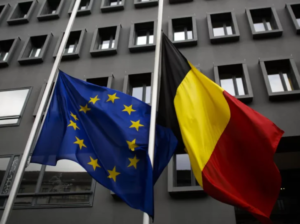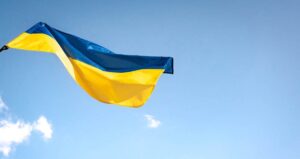
Construction, with a rate of 31.5%, made the largest contribution to Ukraine’s GDP growth in the third quarter of 2025, which, according to preliminary data, amounted to 2.1%, the State Statistics Service reported on Thursday.
According to its estimates of GDP using the production method, growth in public administration was 15.1%, in the supply of electricity, gas, steam, and air conditioning – 6.7%, in wholesale and retail trade and repair of motor vehicles – 2.6%, and in education – 2.2%.
In calculating GDP using the final use (or expenditure) method, which shows where resources in the economy were directed—to consumption, investment, or public services, the main growth in GDP in the third quarter of 2025 was driven by general government expenditure (12.2%) and gross fixed capital formation (or, more simply, investment) (11.5%).
In addition, final household consumption expenditure grew by 6.7%, according to the State Statistics Service.
“In the third quarter, there were significant shifts in the structure: public finances, investment in fixed capital, and household consumption expenditure strengthened noticeably. In terms of production, the main drivers were construction, the public administration sector, energy, trade, and education. It was these sectors that shaped the positive dynamics of the quarter,” said Igor Gonchar, deputy chairman of the State Statistics Service.
The day before, the State Statistics Service reported that Ukraine’s real GDP in the third quarter of 2025 grew by 2.1% compared to the third quarter of 2024, while in the second quarter of this year the same indicator was 0.8%, and in the first quarter – 0.9%.
As reported, at the end of October, the National Bank also estimated Ukraine’s real GDP growth in the third quarter of 2025 at 2.1% compared to the same period last year, while earlier it had forecast it at 2.4%.
According to the updated forecast, the estimate of real GDP growth in the fourth quarter of this year has been revised down to 3.4% from 3.5% in July.
Overall, the National Bank has lowered its GDP growth forecast for 2025 to 1.9% from 2.1% due to energy shortages, the destruction of gas production facilities, and labor shortages, and for 2026 from 2.3% to 2%. The inflation forecast for this year has been improved from 9.7% to 9.2%, while the forecast for next year has been kept at 6.6%.

Turkish President Recep Tayyip Erdogan expressed optimism about the prospects for peace in Ukraine after talks with Vladimir Putin in Ashgabat, Turkmenistan, Turkey’s Anadolu news agency reported.
Erdogan told reporters on the side of the plane that Ankara also hoped to talk to U.S. President Donald Trump to assess a potential peace plan.
“After this meeting with Putin, we hope to be able to also discuss the peace plan with US President Trump. Peace is around the corner; we see it,” Erdogan said, referring to his bilateral meeting with Putin in Turkmenistan on Saturday.
Speaking about regional security, Erdogan warned against turning the Black Sea into a confrontation zone. “The Black Sea should not be seen as an arena of rivalry. It will not benefit Russia or Ukraine. Everyone needs freedom of navigation and security in the Black Sea,” he said.

Belgium is demanding “independent” and “autonomous” guarantees from EU countries in exchange for its support for a loan to Ukraine using frozen Russian assets, Euractiv reports.
The documents, which are currently being discussed by EU ambassadors, come amid frantic efforts by the bloc to persuade Belgium to back the so-called reparations loan ahead of a crucial European Council summit in Brussels next week.
Euroclear, a securities depository headquartered in Brussels, holds the vast majority of the EUR210 billion in frozen assets that will be used to support Kyiv’s military efforts, making Belgium a key player in the EU negotiations.
In a series of amendments to the Commission’s legal proposal, which was first circulated to EU ambassadors last week, Belgium notes that the guarantees must be “independent and autonomous so that they remain in force even if the loan is declared invalid.”
Other key Belgian demands include: other EU states covering potential legal costs that Moscow may claim from any member state; EU capitals refraining from concluding new investment agreements with Russia and cancelling all existing agreements; and a number of other measures to protect Belgium from potential reprisals by Moscow.
Luxembourg and Belgium signed a bilateral investment agreement with the then USSR in 1989, which has not been revoked to date.
In addition, it requires that Euroclear itself “not be liable” for providing the reparations loan, and that its “directors be liable only in cases of gross negligence.”
The Russian Central Bank announced that it would file a lawsuit against Euroclear in a Moscow court on Friday.
Belgium has repeatedly criticized the Commission for continuing with the loan program and has called on other EU countries to support the issuance of joint debt obligations instead. However, the latter option is currently being blocked by Hungary, which is also strongly opposed to the loan program.

The Ukrainian agricultural sector is faced with the need to implement EU standards, which could cost the industry up to €2.5 billion annually, but at the same time opens up strategic opportunities for integration and strengthening Ukraine’s role in global food security, said Andriy Dykun, chairman of the All-Ukrainian Agrarian Council (AUC).
“Calculations show that the introduction of European eco-standards will cost the Ukrainian agricultural sector approximately €2.5 billion per year, which amounts to €70-150 in additional costs per hectare. We must incorporate these standards into our legislation. And at the same time, no one is even talking about giving Ukraine subsidies,“ the association’s press service quoted him as saying at the conference ”Agribusiness in Ukraine.”
He added that environmental standards are currently under pressure in Europe itself.
“It is important to understand that these standards are not yet a certainty in the EU itself. European farmers are also under a lot of pressure, and their green course is constantly changing,” Dykun noted.
After unification, Ukraine and Europe together will be the largest food producer in the world.
“We are the only country that will join the EU with agriculture better than in any other EU country — we are coming in with a high level. But we must unite with Europe not with an “outstretched hand,” but as an equal partner, which together with the EU will become the world’s largest food producer. This needs to be worked out professionally,” the VAS chairman concluded.

€16 million, with EU support, will support procurement of modern trolleybuses and infrastructure improvements
The European Bank for Reconstruction and Development (EBRD) is lending €16 million to the City of Cherkasy in Ukraine to finance the purchase of modern trolleybuses and the upgrade of related infrastructure for the city. The investment will strengthen sustainable urban mobility and ensure uninterrupted public transport services amid the wartime challenges facing Ukraine.
The loan, fully guaranteed by the City, will be co-financed by an investment grant of up to €4 million from the EBRD Shareholder Special Fund and will benefit from partial first loss risk cover under the European Union’s Ukraine Investment Framework Municipal Infrastructure and Industrial Resilience Programme (UIF MIIR). This promotes green transition and resilience in Ukraine’s economy by supporting sustainable investments in green city infrastructure, greening logistics chains, energy efficiency and green technology transfers.
The financing will enable Cherkasyelektrotrans, the municipal public transport operator in Cherkasy, to expand its fleet with new low-floor trolleybuses, modernise depots and other infrastructure, and extend and realign three trolleybus routes.
The project forms part of the EBRD’s Resilience and Livelihoods Framework, aimed at safeguarding essential municipal services during wartime. It will improve mobility for residents, including internally displaced people, and significantly reduce polluting emissions, contributing to better air quality. Aligned with the Paris Agreement’s mitigation and adaptation goals, the project is classified as 100 per cent green finance.
It also promotes inclusion by increasing accessibility for passengers with limited mobility and supporting gender equality through a partnership with UN Women’s She Drives programme, which will train and certify women and youth as trolleybus drivers.
By investing in Cherkasy’s public transport system, the EBRD is helping to maintain vital services, strengthen resilience and advance Ukraine’s green transition during a time of unprecedented challenge.
The EBRD has substantially increased its investments in Ukraine since Russia began its full-scale war there in 2022, deploying more than €8.5 billion to support energy security, vital infrastructure, food security, trade and the private sector.

Over UAH 13.7 billion has been borrowed by Ukrainians from microfinance organizations over the past three months, which is more than 2 million microloans. In total, 6.5 million microloans worth UAH 40 billion have been issued since the beginning of the year. The average amount of a microloan in Ukraine is UAH 6,417. In total, citizens currently owe more than UAH 25 billion to microcredit organizations. The amount of debt has increased by 26% since the beginning of the year.
Ukrainians took out 2,138,569 microloans in the third quarter. The quarter-on-quarter loan growth rate is slightly lower – about 2%. Over the past three months, more than UAH 13.7 billion has been borrowed from microcredit organizations.
In total, since the beginning of the year, microloans have been applied for more than 6 million times, with the total amount of loans amounting to more than UAH 40 billion.
Despite the fact that the number of microloans is decreasing, the average loan amount per quarter has increased. Currently, the average amount borrowed from MFIs is UAH 6,417. For comparison, at the beginning of the year, payday lenders borrowed UAH 5,773.
Microloans are not as well repaid: since the beginning of the year, the total amount of debt has increased by a quarter and reached UAH 25.15 billion.
Opendatabot analyzed the financial reporting data of microfinance organizations – among those that have already published this information – and compiled a rating of the country’s top 10 MFIs by income. The top ten in the first three quarters of 2025 was headed by UKR CREDIT FINANCE, which operates under the CreditKasa brand with a revenue of UAH 2.4 billion. For comparison, for the whole of last year, the company’s revenue amounted to UAH 4.2 billion. Credit plus (AVENTUS UKRAINE) is in second place with revenue of UAH 1.67 billion. The top three payday lenders are rounded out by ShvydkoGroshi (CONSUMER CENTER) with UAH 1.63 billion in revenue for the three quarters of this year.
https://opendatabot.ua/analytics/mfo-2025-9

